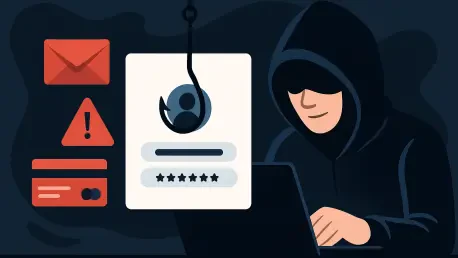What if a single click could unravel years of coding work or expose sensitive personal data to malicious hands? For Python developers relying on the Python Package Index (PyPI), this nightmare is becoming a stark reality as sophisticated phishing attacks target users and maintainers with alarming precision, using deceptive emails and fake websites to steal credentials. This escalating threat has put the entire Python community on edge, raising urgent questions about security in the open-source world.
Why Python Developers Are in the Crosshairs
The Python ecosystem, with PyPI as its beating heart, serves millions of developers worldwide, making it a prime target for cybercriminals. Attackers see an opportunity to infiltrate not just individual accounts but entire projects that power global software. The sheer scale of dependency on Python libraries means a single breach could ripple through countless systems, amplifying the potential damage.
These phishing campaigns are not random; they are meticulously crafted to exploit trust within the community. Developers, often juggling tight deadlines, may not always spot the subtle red flags in a well-disguised email. This vulnerability, combined with the high value of PyPI credentials, explains why attackers are zeroing in on this group with relentless focus.
The Escalating Danger to PyPI and Open-Source Platforms
Phishing attacks on PyPI have evolved into a sustained threat, persisting for months with no sign of slowing down. As the central repository for Python software, PyPI holds immense value for attackers seeking to compromise widely used packages or infiltrate broader networks. The open-source nature of the platform, while a strength for collaboration, also exposes it to risks that proprietary systems might avoid.
Unlike traditional hacks that exploit code vulnerabilities, these schemes prey on human behavior. Attackers craft messages that instill panic, such as warnings of account suspension, pushing even savvy users to act impulsively. With open-source software underpinning critical infrastructure globally, the need to secure platforms like PyPI has reached a critical juncture.
Dissecting the Phishing Tactics Aimed at Developers
The methods behind these attacks are both cunning and calculated, designed to bypass suspicion. Fraudulent emails often pose as urgent security alerts, demanding that users “verify” their accounts to avoid dire consequences like account deletion. These messages are polished, often mimicking official PyPI branding to appear legitimate at first glance.
A common trick involves directing victims to typosquatted domains—fake websites with names like pypi-mirror.org that closely resemble the real PyPI site. Once there, unsuspecting developers enter their credentials, handing them directly to attackers. This blend of technical deception and psychological pressure makes these campaigns particularly dangerous.
According to Seth Larson, PyPI’s security developer-in-residence, these efforts are part of a long-running operation. He warns that attackers continuously adapt, rolling out new domains and tactics to stay ahead of detection. This persistence highlights the challenge of staying one step ahead in an ever-shifting threat landscape.
Voices from the Frontlines of Cybersecurity
Security experts are sounding the alarm on the enduring nature of these phishing efforts, stressing that human error remains the weakest link. Seth Larson has been vocal about the ongoing battle, stating, “These attacks are not isolated; they build on past campaigns, and more will come with fresh deceptive strategies.” His words serve as a stark reminder of the continuous vigilance required.
Stories from affected developers paint a vivid picture of the real-world impact. One maintainer recounted how a fleeting moment of distraction during a hectic day led to clicking a malicious link, nearly compromising a widely used package. Such anecdotes reveal how even brief lapses can have devastating consequences, reinforcing the urgency of robust defenses.
Beyond individual experiences, the broader security community agrees that phishing thrives on exploiting trust and urgency. Experts advocate for a cultural shift toward skepticism, urging developers to question every unexpected request. This collective insight underscores that technology alone cannot solve a problem rooted in human psychology.
Practical Defenses Against Phishing Threats
Staying safe as a Python developer starts with simple but effective habits. If there’s any doubt about compromised credentials, changing passwords immediately and reviewing account activity for anomalies is critical. Reporting suspicious emails or links to PyPI’s security team can also help mitigate risks and protect others in the community.
Beyond reactive measures, adopting stronger security tools offers a proactive shield. Phishing-resistant two-factor authentication, such as hardware tokens, adds a layer of protection that passwords alone cannot provide. For maintainers, password managers that only auto-fill on trusted domains serve as an early warning system against fake sites.
Perhaps the most powerful defense is a mindset of caution. Developers should hesitate before clicking any link, especially those claiming urgency, and independently verify the sender or website through known channels. Combining this vigilance with technical safeguards creates a formidable barrier against even the most sophisticated phishing attempts.
Reflecting on a Battle Fought with Caution and Tools
Looking back, the fight against phishing attacks on Python developers revealed a dual challenge: outsmarting both deceptive technology and human vulnerabilities. The community faced relentless campaigns that tested their resolve, from cunning emails to fake domains designed to steal credentials. Each incident served as a lesson in the importance of staying alert.
The response from developers and PyPI alike showed a determined effort to adapt, with many embracing tools like two-factor authentication and password managers. Education played a pivotal role, as warnings and shared experiences helped spread awareness of the tactics used by attackers. These collective actions marked a turning point in building resilience.
Moving forward, the focus shifted toward sustained prevention and innovation in security practices. Developers were encouraged to integrate advanced protections into their workflows and remain skeptical of unsolicited communications. The path ahead demanded not just reaction, but anticipation—staying ready for the next wave of threats with sharper tools and keener instincts.









